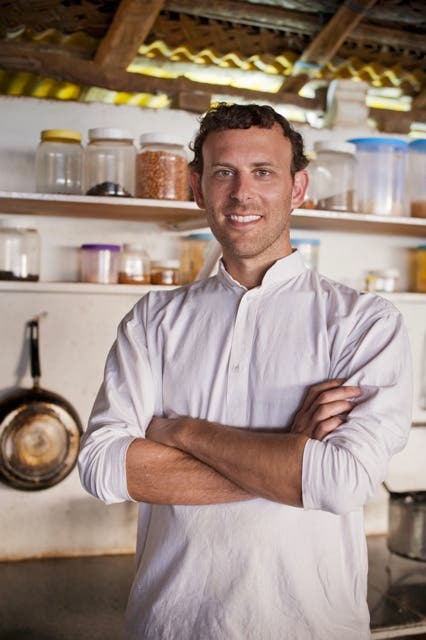Ask a Chef: Daniel Biron


Daniel Biron falls under that lucky category of “globetrotting chef.” The 37-year-old ethical vegan hails from Brazil, but has lived and cooked in Paris, New York, and—most recently—Copenhagen, where he exercised his culinary talents in one of the world’s most celebrated restaurants, Noma. Now back in Rio de Janeiro, Daniel shares his kitchen credo and serves it with a scoop of food forecasting.
You’re originally from Brazil and studied at the Natural Gourmet Institute. How did you end up moving to Paris?
During culinary school, I fell in love with New York’s vegan food scene and stayed for two years while doing a few internships and projects, such as recipe testing for the Candle 79 cookbook. In October 2011, I volunteered at the Paris Vegan Day event, and I met Deborah Pivain and everyone from Gentle Gourmet. The Gentle Gourmet Café was still a project, and once they decided to move forward I got invited to be the opening chef. It was an incredible opportunity, so I moved to Paris in May 2012.
You recently spent one month at revered Copenhagen restaurant Noma. Tell us about your experience there.
Noma is a unique place. Employees from all over the world share and give their best, while eager to learn Nordic contemporary cuisine. As a two-star Michelin rated restaurant, expectations are high, and we were constantly pushed to our limits. Although one month would never be enough to comprehend what goes on in all sections of the kitchen and in service, it was a good opportunity to show that we don’t need to compromise flavor when eating vegan.
What are some Brazilian food specialties vegetarians can look forward to trying when visiting?
Brazil is large and diverse, so that varies by region. You can find naturally veg food everywhere: fresh juices, vegetables, fruits, beans, grains, nuts, and seeds. Another good example is tapioca. It is made of manioc (cassava) and it’s been a staple in northeast Brazil for centuries. It has become a very trendy food in cities like Rio de Janeiro and São Paulo. “Cuscuz de Tapioca” is a sweet treat made of coconut, coconut milk, sugar, and tapioca flour. Tapioca crêpes, manioc fries, and manioc flour (farofa) are also great and vegan most of the time.
Rumor has it you’re launching a restaurant this year. What can you tell us about it?
I am very excited about it. As vegan food goes mainstream in many cities across North America and Europe, the trend is slowly arriving in Brazil, where most vegetarian restaurants still have a New Age-y, natural-foods look. Our restaurant will have contemporary décor and ambiance and professional service. Ultimately, our intention is to make a regular restaurant that happens to be plant-based and that can surprise vegans, vegetarians, and omnivores alike, with beautiful and tasty food.
What is your food philosophy, and what dish of yours exemplifies that?
I am opinionated in terms of using whole, fresh, organic, seasonal, and local products. I like making most preparations from scratch. I support fair trade, sustainable sourcing, local communities, and social responsibility. I’m fond of contemporary international vegan cuisine, with influences from several ethnic cuisines around the globe. I am also fascinated by street and comfort foods; I like fusing elements from that with contemporary techniques. In my opinion, food must be as nourishing to the eye as [it is] to the palate.
I love a regional Brazilian dish called Moqueca (pronounced “mo-KEH-kah”). The vegan version uses vegetables, seaweed, fresh hearts of palm or plantains, and is served with white rice and Pirão (a tapioca flour purée). I created a vegan Moqueca risotto that combines some of those ingredients in risotto form, with whole-grain Arborio rice and seasonal veggies.
What indispensible culinary tip can you offer chefs and home cooks?
It would certainly be to develop curiosity. That means: explore the food universe and constantly experiment; get to know ingredients, farmers, production methods, and cooking techniques; eat out and experience new flavors and popular food culture; travel, refine your taste buds, and share knowledge; be open to feedback, challenge yourself, and never be afraid to ask.
Are there any food trends that you are excited about right now?
I was recently reading the American National Restaurant Association 2014 Culinary Forecast, and I got excited to see that so much of my food philosophy is considered a trend. Fresh and organic, locally grown produce, whole and healthy meals, traditional foods, raw and living foods, environmental sustainability, and gluten-free cuisine. The most exciting trend, though, is having vegetables as the centerpiece of the plate, hence the amount of high-end restaurants offering vegetarian tasting menus.
For me, those “trends” just naturally seem to be the right thing: for the animals, for our health, for future generations, and for the environment. I don’t see them as trends, but as necessary steps to a more just, compassionate, and sustainable planet.
——-
Aurelia d’Andrea’s passion for travel is deeply intertwined with her love of food. Whether in Perth, Prague, or Phnom Penh, she always gravitates toward local markets in search of edible treasures, and takes pleasure in recreating tasty travel memories at home in her tiny Parisian kitchen.